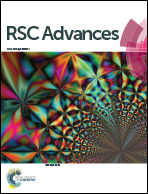Improving the electrochemical properties of polyamide 6/polyaniline electrospun nanofibers by surface modification with ZnO nanoparticles
Abstract
Heterostructured nanomaterials have attracted increasing interest because of their novel and distinct optical and electrical properties, finding applications in devices and chemical sensors. Here we report a new electrochemical platform based on the modification of fluorine doped tin oxide (FTO) electrodes with polyamide 6/polyaniline (PA6/PANI) electrospun nanofibers decorated with ZnO nanoparticles. The nanoparticles were synthesized by a co-precipitation method, followed by hydrothermal treatment; the route was optimized in order to obtain particles of small average diameter (45 nm). Polymeric nanofibers were obtained by the electrospinning technique and further subjected to ZnO modification by nanoparticle impregnation. SEM images confirmed the uniform distribution of ZnO nanoparticles adsorbed onto the nanofiber surface, the amount of which was estimated to be 4% w/w, according to thermal gravimetric analysis (TGA). According to the electrochemical characterization, an improvement in electron transfer kinetics and increase in electroactive area was observed for the ZnO-modified FTO electrode. The modified electrode was employed for monitoring hydrazine, and yielded a detection limit of 0.35 μmol L−1. Our results indicate that the novel sensing platform based on the adsorption of ZnO nanoparticles onto the surface of electrospun nanofibers can be potentially harnessed for electrochemical sensor and biosensor applications.


 Please wait while we load your content...
Please wait while we load your content...